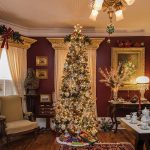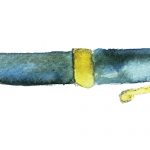One of our smallest local breeding birds
By Susan Campbell
If you have ever heard the sound of what seems to be a squeaky toy emanating from the treetops here along the coast, you may have had an encounter with a brown-headed nuthatch. This bird’s small size and active lifestyle make it a challenge to spot, but once you know what to look and listen for, you will realize it is a common year-round resident throughout our state’s piney woods.
Brown-headeds are about 4 inches long with gray backs, white bellies and as the name suggests, brown heads. And in this species, males are indistinguishable from females. Their coloration creates perfect camouflage against the tree branches that the birds can be found foraging on, in search of seeds and insects. Their oversized bill allows them to pry open a variety of seeds as well as pine cones and dig deep in the cracks of tree bark for grubs. By virtue of their strong feet and sharp claws, brown-headed nuthatches are capable of crawling head-first down the trunk of trees as easily as going up. Although they do not sing, these birds have a distinctive two-syllable squeak, which they may roll together if they are especially excited.
Brown-headed nuthatches do take advantage of feeders. One of the best places to view them is the feeding stations at either Fort Fisher or Carolina Beach State Park. They are probably the most common visitor on any day of the year. Brown-headeds frequent both the sunflower seed feeders and suet from dawn until dusk. They are very accustomed to people, so viewing at close range is possible — as are fantastic photo opportunities, particularly in the colder months.
This species is one of our area’s smallest breeding birds. It is a nonmigratory resident, living as a family group for most of the year. Unlike its cousin, the white-breasted nuthatch, which can be found across the state, the brown-headed is a bird of the mature pine forest. Brown-headeds are endemic to the southeastern United States, from coastal Virginia through most of Florida and west to the eastern edge of Texas. Their range actually covers the historic reaches of the longleaf pine. However, in the absence of the longleaf, this little bird has switched to using other species of pine, such as loblolly and Virginia pine.
Brown-headed nuthatches are capable of excavating their own nest hole in small dead trees in early spring. But because so few of the appropriate sized trees are available (due to humans tidying up the landscape), nuthatches have taken to using nest boxes in recent years. However, unless the hole is small enough to exclude larger birds such as bluebirds, they may be out-competed for the space. For this reason the species is now one of concern across the Southeast, with populations in decline. In addition to reductions in breeding productivity, logging, fire suppression and forest fragmentation are causing significant challenges for this feisty little bird. For these reasons, in 2015 Audubon North Carolina launched an endeavor to encourage homeowners in brown-headed nuthatch habitats to add a nest box or two to give them a hand. Not surprisingly, it took less than a year to add 10,000 new boxes across the state.
One of the most unexpected finds from long-term research on this species has been that “helper males” have been documented assisting parents with raising subsequent generations. Without unoccupied territory nearby, young males may consciously be choosing to stay with their parents in hopes that they may inherit their father’s breeding area over time. If this approach sounds at all familiar to bird enthusiasts in our region, it should! This is akin to the strategy of the red-cockaded woodpecker, another well-known, albeit less abundant, inhabitant of southeastern pine forests.
Regardless, brown-headed nuthatches are one of the most charismatic bird species in our area. Their fearlessness and unique vocalizations endear them to so many, even those who are not self prescribed birdwatchers. Just about anyone who cocks an ear to their squeaky calls and catches a glimpse of these squatty characters cannot help but become enamored by these very special little birds that call the North Carolina pines home.
Susan would love to receive your wildlife sightings and photos at [email protected].


